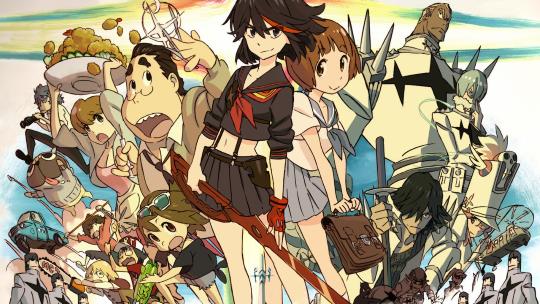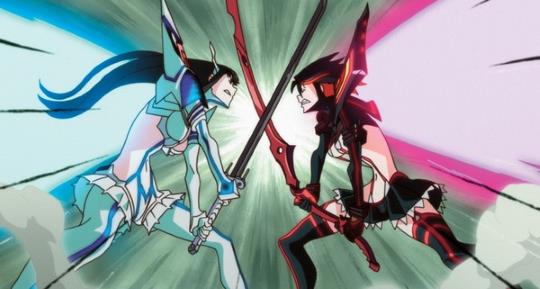Silver Screenings: Kill la Kill
As I mentioned last time on Silver Screenings, Kill la Kill’s complete lack of restraint is perhaps its greatest vulnerability. It has a lot of interesting ideas and themes going for it, but the goal of delivering them all in outrageous, outlandish fashion muddles any message being communicated.
So why don’t we start with the beginning? The opening four minutes of the very first episode embedded above is actually packed dense with the ideas this anime is trying to convey.
The general over-the-top and somewhat comedic tone is established efficiently. We can see that Kill la Kill has no regard for the laws of physical reality, instead over-dramatizing everything into amusing spectacle. We recognize a character like Gamagoori as strong and imposing, but he’s not portrayed in a sinister or frightening fashion. We may even laugh at seeing him simply falling through the air outside the windows as the student desperately flees.
This is the easy stuff. What’s more surprising is how many of the show’s themes are succinctly introduced within these few goofy minutes.
First are the uniforms. We discover the in-universe rule that uniforms grant power, and that the different stars denote the amount of strength, speed, and other attributes they grant. In other words, better clothes make the person wearing them better.
The removal – destruction, even – of that uniform thus leaves the user nude. The first person we see stripped of clothing is a man, and his nudity is vulnerability and humiliation.
These are the basic foundations in which Kill la Kill’s themes are built.
It’s not just clothing as status, though that is certainly at the forefront. It’s the competition for better status, as primarily represented through the school uniforms. Characters and their social hierarchy are defined by their uniform. The vast majority of the students are referred to as “no-stars”, garbed in the most basic outfit available. By having no stars they are relegated to the vast slums outside of the academy’s walls. Those bearing single-star uniforms not only get a modicum of increased power, they also get to live in more comfortable, relatively middle-class homes. Students with two-star outfits are moved to a wealthier, upper-class neighborhood. As the number of stars increase, the size of the neighborhood shrinks.
Alright, so we have a manifestation of social hierarchies represented by uniforms. What’s so special about that? Consider again that these aren’t just any uniforms, but school uniforms. Why would Kill la Kill take place in a school? Is it just because high school is a popular setting in anime?
That’s no doubt part of the angle they’re lampooning, as hardly any school actually happens in Kill la Kill. Like those other anime, the actual life of the Japanese teenager is hardly reflected in the fantastic realities of these characters.

Japan is an incredibly competitive country. Students stress out about entrance exams to high-school level schools. While there’s no guarantee of success in life for attending a prestigious school, society impresses such notions upon the impressionable and young student body. It’s the pressure American high school students face when choosing what College they’ll go to, only rather than taking the standardized SAT’s you need to take a specialized exam for each institution… just to get into high school.
One of the leading causes of suicide among the young in Japan is stress suffered through extensive studying or failure to reach that prestigious school they had pinned their hopes and dreams on.
From a Western perspective, the outrageous competition of students desperate to secure a better life within Kill la Kill’s Honnōji Academy may seem like simple greed, but it is a very specific reflection of how ridiculous standards are impacting the youth of Japan. You are only worth as much as the stars on your uniform.
Most Western adolescents likely feel a disgust to the idea of having to wear a uniform. Not only do they tend to be less comfortable, school uniforms interfere with self-expression. This is certainly part of the point, developing a unified standard by which everyone exists. Kill la Kill itself makes a direct reference to the military, and in Satsuki Kiryuin’s journey to dominate all other schools, these uniforms are the key to victory. Once again, typical school competitions such as kendo and tennis are transformed into something vicious by the desire to be better than others. While the vast majority of students within the show’s crowds are drawn the same for cost-cutting and even comedic measures, it is also an intentional choice to signify the loss of identity to these individuals.
Which is where Ryuko Matoi and her unique uniform Senketsu come in. By having a unique uniform she manages to maintain individuality, standing apart from the rest of the students. It also helps grant her power, but only when its true form is unleashed.
A form that is incredibly revealing.

Remember that in the first episode’s introduction nudity is humiliation and vulnerability. Even no-stars have a uniform, after all. To be without uniform is to be nothing. If your uniform determines your standing in society, then having none makes you unfit for being in society altogether. If Satsuki keeps referring to everyone as “pigs in human clothing”, then removal is to be a pig. Or rather, not human.
Ryuko’s first feelings towards the lecherous outfit is embarrassment and even shame. Young men oggle and drool over her like she’s a piece of meat – perhaps delicious, tasty bacon! Ryuko feels vulnerable and exposed.
Here we have our first contradiction – the common contradiction of sexuality. Ryuko on one hand feels more vulnerable because she is exposed, even though that same exposure empowers her above others.
I wish I could begin to start pulling all these threads together into a gorgeously colorful quilt, but as stated, the over-the-top nature of Kill la Kill ultimately causes it to be a gorgeous quilt on one end and a patchwork mess on the other. Exposure of skin can be humiliating and objectifying while simultaneously being empowering. The members of resistance group Nudist Beach are themselves able to find strength in their rejection of clothing.
At the same time, this extreme has its own contradictions. While Nudist Beach has no real hierarchy like uniformed society, the different members still lose their individuality. Without uniforms they lack the unique traits those uniforms strengthened.
Which is where we begin to have a sort of vague conclusion to all of these ideas. When the elite three-star students are first introduced, their uniforms completely conceal or distract away from their proper form. As time progresses, their outfits cover half of their bodies while exposing the rest. Clothing doesn’t have to strip you of your identity. It can empower you and let your true self shine.
...a…slightly ridiculous sounding concept when you consider the ideas the show starts with.
Or perhaps we should instead look at Satsuki herself, who does not allow herself to be humiliated regardless of her circumstance. No matter what she wears or does not wear, she stands tall and proud. She is not victim to the impressions of others but exudes her will regardless. This could imply that it is you that defines who you are, not what clothing or the quantity draped upon your shoulders.
As I said, Kill la Kill is a patchwork. It has a lot of fascinating ideas woven into it, but it doesn’t successfully form a coherent pattern. The plot resolves fine, but the thematic ideas you thought you were following often end in question marks.
It is still one of my favorite shows out there – one I will repeatedly come back to. Even if I am never satisfied with how its thematic threads come together, I still find the resulting quilt wonderful to study and admire.


